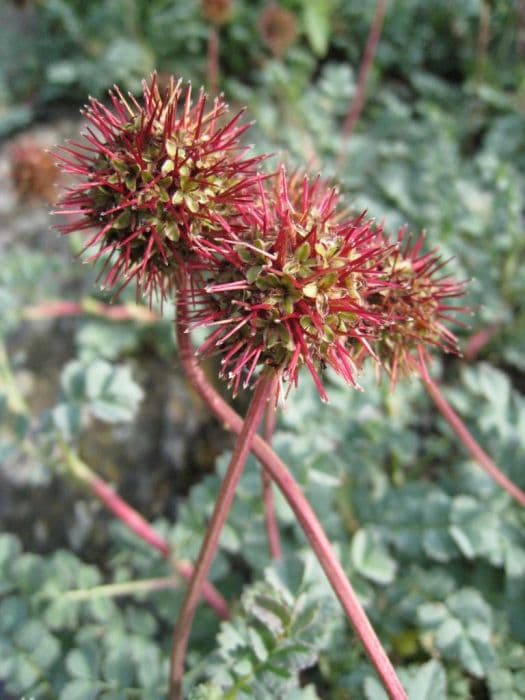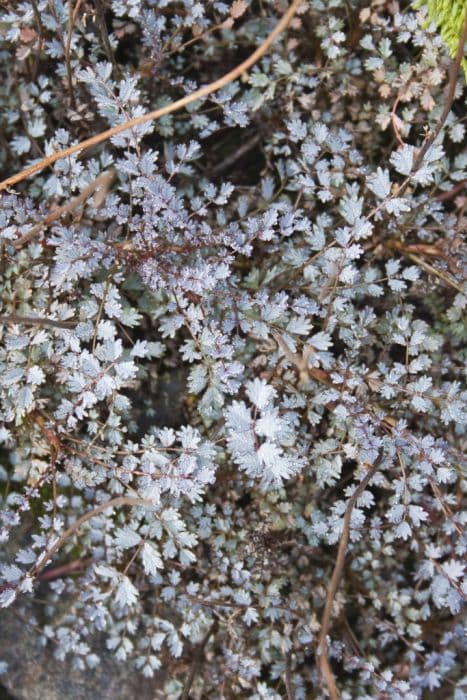Flower Carpet Rose Rosa Flower Carpet Sunset = 'Deseo' (S)

ABOUT
The Rosa Flower Carpet Sunset, commonly referred to simply as Flower Carpet Rose, is a captivating ground cover rose that boasts a lush, spreading habit. The foliage of this vibrant plant is glossy and deep green, providing an elegant backdrop to the stunning flowers. The blossoms themselves are semi-double and sport a warm, rich blend of orange and yellow hues that invoke the image of a picturesque sunset. Each flower is adorned with a lovely array of petals that unfold in a whirl of colors, creating a cheerful and inviting aspect. As the season progresses, the blooms continuously grace the plant, offering a long-lasting display of beauty. The Flower Carpet Rose is notably robust, with a natural resilience to diseases that often affect other rose varieties. The overall appearance of this rose is one of grace and vivacity, with its colorful blossoms creating a striking contrast against the glossy leaves, lending an enduring allure to any garden space.
About this plant
 Names
NamesFamily
Rosaceae
Synonyms
Flower Carpet Sunset Rose, Groundcover Rose, Carpet Rose
Common names
Rosa 'Noalesa', Rosa Flower Carpet Scarlet.
 Toxicity
ToxicityTo humans
The plant commonly known as the Rose is not considered toxic to humans. If any part of the rose plant is ingested in normal quantities, it is not expected to cause serious harm or symptoms of poisoning. However, like any plant material that is not typically consumed as food, ingestion might result in a mild stomach upset in some individuals.
To pets
The Rose is generally considered non-toxic to pets. It is not known to cause serious poisoning if ingested by animals such as dogs or cats. Sometimes if a pet eats rose leaves or flowers, they may experience mild gastrointestinal upset, but serious consequences are unlikely.
 Characteristics
CharacteristicsLife cycle
Perennials
Foliage type
Deciduous
Color of leaves
Green
Flower color
Orange
Height
2-3 feet (0.6-0.9 meters)
Spread
2-3 feet (0.6-0.9 meters)
Plant type
Shrub
Hardiness zones
5-9
Native area
Hybrid origin
Benefits
 General Benefits
General Benefits- Easy to care for – The Rosa Flower Carpet requires minimal pruning and is relatively low-maintenance, ideal for both new and experienced gardeners.
- Disease resistance – This variety is known for its resistance to common rose diseases such as black spot and mildew, reducing the need for chemical treatments.
- Continuous blooming – Flower Carpet roses have a long flowering season, offering repeated blooms from late spring until frost.
- Drought tolerance – Once established, these roses are tolerant to dry conditions, making them suitable for water-wise gardens.
- Versatile landscaping – Can be used for ground cover, borders, or as a colorful addition to containers.
- Attracts pollinators – The flowers attract bees, butterflies, and other beneficial insects, promoting a healthy garden ecosystem.
- Vibrant color – The Sunset 'Deseo' variety showcases warm, vibrant hues that can create an eye-catching display in any landscape.
 Medical Properties
Medical PropertiesThis plant is not used for medical purposes.
 Air-purifying Qualities
Air-purifying QualitiesThis plant is not specifically known for air purifying qualities.
 Other Uses
Other Uses- Living Plant Jewelry: Small cuttings of the flower carpet rose can be used to create living jewelry, such as earrings or pendants, providing a unique, natural accessory that will continue to bloom for a short time when properly cared for.
- Natural Dye: The petals of the rose can be boiled to extract a natural dye for fabrics, offering hues from pale peach to vibrant orange depending on the concentration and fabric treatment.
- Floral Art: The blooms and foliage can be used in floral art, such as by creating intricate pressed flower designs for decorative home art or handmade greeting cards.
- Eco-friendly Confetti: Dried petals of the flower carpet rose can be used as biodegradable confetti for outdoor celebrations, reducing the environmental impact compared to traditional paper or plastic options.
- Photography Props: These roses can be used by photographers seeking to add a splash of color and natural beauty to their photos, especially in portrait and wedding photography.
- Scented Drawer Liners: Dried petals can be placed in cloth sachets and used as scented drawer liners to impart a subtle rose fragrance to linens and clothing.
- Bathwater Infusion: Fresh petals can be added to bathwater for a luxurious, fragrant bathing experience reminiscent of royal or spa treatments.
- Edible Flower Garnishes: Although unconventional, the petals of roses that have not been treated with pesticides can be used to garnish desserts and cocktails, adding an elegant touch.
- Homemade Potpourri: Petals can be dried and mixed with other herbs and spices to create homemade potpourri, providing a natural way to freshen indoor spaces.
- Ice Cube Embellishments: Freeze small rose petals into ice cubes for a decorative touch in punches and cold beverages during special events and gatherings.
Interesting Facts
 Feng Shui
Feng ShuiThe Rose is often associated with attracting love chi and can be placed in the southwest sector of a garden or home to enhance relationships and romance in accordance with Feng Shui principles.
 Zodiac Sign Compitability
Zodiac Sign CompitabilityThe Rose is not used in astrology practice.
 Plant Symbolism
Plant Symbolism- Love: Roses are universally regarded as symbols of love, and the Rosa Flower Carpet Sunset, with its warm hues, evokes emotions of passion and romance.
- Beauty: The aesthetic appeal of roses is undeniable, and they often symbolize beauty both external and internal.
- Balance: The harmonious blend of colors in the Rosa Flower Carpet Sunset suggests balance and unity, making it a symbol of equilibrium in life.
- Optimism: The bright and cheerful appearance of this rose can represent optimism and a positive outlook on life.
- Devotion: Just as roses are committed to growing and blooming, they can signify a person's dedication and commitment to a relationship or cause.
- Renewal: Roses go through cycles of growth, bloom, and renewal, symbolizing new beginnings and fresh starts.
 Water
WaterFlower Carpet roses like 'Deseo' require deep watering to ensure the root system develops well, especially during the first growing season. After establishment, water the plant thoroughly every week, providing at least 1 gallon of water per plant. During periods of extreme heat or drought, increase watering frequency to twice per week, ensuring the soil is moistened to a depth of about 18 inches. In cooler weather or if rainfall is sufficient, reduce the amount accordingly. Avoid overhead watering to minimize the risk of disease.
 Light
LightThe ideal lighting condition for a Flower Carpet rose such as 'Deseo' is full sun, which entails at least 6 to 8 hours of direct sunlight daily. They can tolerate some light shade, but too much shade can result in fewer blooms and a higher susceptibility to diseases. The best spot for planting 'Deseo' is in an area where it can receive morning sun and some afternoon shade in extremely hot climates.
 Temperature
TemperatureFlower Carpet roses like 'Deseo' prefer a temperate climate and typically thrive in USDA hardiness zones 5 through 10. They are hardy in temperatures as low as -20 degrees Fahrenheit during dormancy and can handle summer heat up to the mid-90s. Ideally, maintain a temperature range between 65 and 75 degrees Fahrenheit for optimal growth and flowering.
 Pruning
PruningPrune Flower Carpet roses like 'Deseo' mainly to shape the plant, remove dead wood, and encourage vigorous growth and blooming. The best time for pruning is in late winter or early spring, before new growth starts. Flower Carpet roses can be pruned more aggressively than other rose types, cutting back to about 1/3 of their size if needed. It's also beneficial to conduct light pruning throughout the growing season to remove spent flowers and any dead or diseased branches.
 Cleaning
CleaningAs needed
 Soil
SoilThe Flower Carpet Rose requires well-draining, loamy soil with a pH between 6.0 and 7.0. Add organic matter like compost and aged manure to enrich soil nutrients. Use a balanced fertilizer for optimal growth.
 Repotting
RepottingFlower Carpet Roses are not typically grown in containers; therefore, they don't need repotting. Instead, ensure they're planted in-ground with enough space to accommodate their growth.
 Humidity & Misting
Humidity & MistingFlower Carpet Roses thrive best in moderate humidity conditions. They adapt to the outdoor ambient humidity but avoid overly humid microclimates to reduce disease risk.
 Suitable locations
Suitable locationsIndoor
Ensure ample light, proper watering, and occasional pruning.
Outdoor
Plant in full sun, in well-draining soil, and space adequately.
Hardiness zone
5-10 USDA.
 Life cycle
Life cycleThe life of the Flower Carpet Rose begins with seed germination, where the seed must be sown in well-draining soil and given appropriate warmth and moisture to sprout. Following germination, the seedling emerges and develops its first set of true leaves, entering a period of vegetative growth where it establishes a strong root system and foliage. The plant then transitions to the flowering stage, producing vibrant pink flowers that attract pollinators and may set seeds if fertilized. After flowering, the Flower Carpet Rose enters a phase of senescence for its blooms, where petals wilt and drop, and the plant may produce hips (fruit) containing seeds. During the winter or dormant period, growth slows or ceases, and the plant conserves energy, potentially shedding leaves in colder climates. As the cycle repeats with the return of favorable conditions in spring, the rosebush resumes active growth, leading to another flowering phase.
 Propogation
PropogationPropogation time
Spring to Summer
Propogation: The Rosa Flower Carpet Sunset, more commonly known as the Flower Carpet Rose, is often propagated by semi-hardwood cuttings, a process best undertaken during the late summer months. This preferred method involves taking a cutting of about 6 inches (15 centimeters) long from a healthy, disease-free parent plant. The bottom leaves are removed, and the cut end is dipped in a rooting hormone to encourage root development. The prepared cutting is then inserted into a pot filled with a mixture of peat and perlite or a well-draining potting mix. The container should be kept in a warm environment with indirect light and consistently moist soil. Root formation generally occurs within several weeks, after which the rooted cutting can be gradually acclimated to outdoor conditions before planting in the garden.









